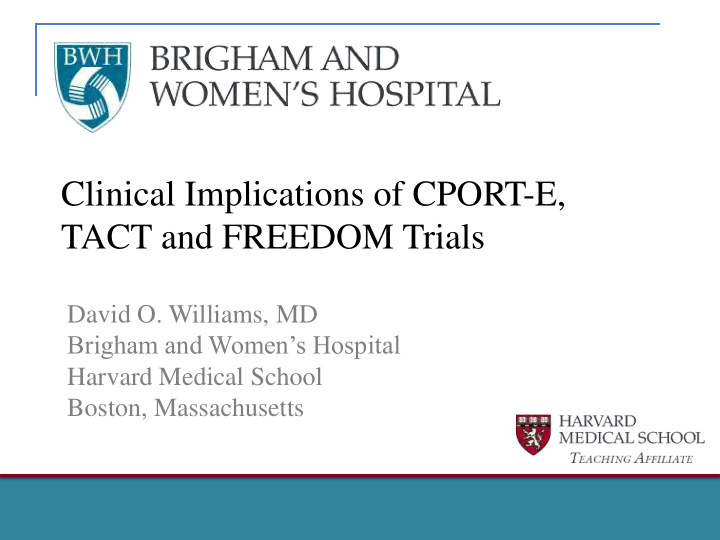



Clinical Implications of CPORT-E, TACT and FREEDOM Trials David O. Williams, MD Brigham and Women’s Hospital Harvard Medical School Boston, Massachusetts
CPORT Purpose • To compare the outcomes of elective PCI performed at hospitals with to those without on-site cardiac surgery Methods • 3:1 randomization assignment to PCI at a hospital without or with on-site cardiac surgery. • Two primary end points: mortality at 6 weeks; incidence of major adverse cardiac events (composite of death, Q-wave myocardial infarction, or target-vessel revascularization) at 9- months. NEJM 2012;366:1792
CPORT Findings • 18,867 patients were enrolled. • 6-week mortality rate was 0.9% at hospitals without on-site surgery versus 1.0% at those with on-site surgery. • 9-month rates of major adverse cardiac events were 12.1% and 11.2% at hospitals without and those with on-site surgery, respectively. • Rate of target-vessel revascularization was higher in hospitals without on-site surgery (6.5% vs. 5.4%, P=0.01). NEJM 2012;366:1792 3
CPORT Conclusion • PCI performed at hospitals without on-site cardiac surgery was non-inferior to PCI performed at hospitals with on-site cardiac surgery with respect to mortality at 6 weeks and major adverse cardiac events at 9 months. NEJM 2012;366:1792
CPORT Commentary and Clinical Implications • Extremely well organized and well conducted trial • Large study and findings are valid • To be applicable, hospitals will need to replicate all necessary operational and training activities inherent in the trial • Endpoints limited to “safety.” Did not investigate “efficacy.” Efficacy may have been less at the non-CABG hospitals as reflected in the increased rate of repeat procedures. This aspect of the questions remains to be answered. • This trial will likely impact manner in which PCI performed in the United States. The performance of PCI at hospitals without on-site CABG will be adopted and become the standard of care. 5
TACT Purpose • To determine the effects of chelation therapy on cardiovascular outcomes in patients with history of myocardial infarction Methods • Age equal to or greater than 50 years • Random assignment to EDTA or placebo • Two-by-two factorial design: high-dose vitamins or placebo • Composite endpoint: all-cause death, recurrent MI, stroke, coronary revascularization or hospitalization for unstable angina 6
TACT Findings • Trial started in 2003 • 1,708 patients randomized to infusions of EDTA or placebo • Minimum follow-up of 55 months • Most patients did not receive all infusions and many withdrew from the study, were lost to follow-up or discontinued the intervention • For the primary endpoint, there was benefit for those assigned to the chelation group, HR 0.82, 95% CI (0.69-0.99), P=0.035. • Subgroup analysis demonstrated benefit for those with diabetes and no benefit for those without diabetes, HR 0.61, 95% CI (0.45, 0.83), P=0.002. 7
TACT Conclusion • EDTA therapy reduced cardiovascular events in post-MI patients 8
TACT Commentary and Implications • Many patients did not receive complete study therapy. • A substantial number of patients dropped out of the trial. Their outcomes did not contribute to the follow-up data provided. • The primary endpoint was a composite of many different cardiovascular events. Data for individual events were not provided. • No benefit for angina. • Although there were some aspects of the trial that suggested chelation may be beneficial, too many questions remain to recommend chelation as standard therapy at this time. 9
FREEDOM Purpose • To determine whether percutaneous coronary revascularization with drug-eluting stents (PCI) is as effective as coronary artery bypass surgery (CABG) for treatment of multivessel CAD among patients with diabetes. Methods • Randomly assigned 1,900 patients with diabetes mellitus (Type 1 or Type 2) and multivessel CAD to either PCI or CABG • Patients had an indication for revascularization based upon symptoms of angina and/or objective evidence of myocardial ischemia. • Endpoints: All-cause death, MI and stroke at a minimum of 2- years 10
FREEDOM Findings at Five-Years • Composite rates of death, MI and stroke were high and significantly higher among patients assigned to initial PCI than those assigned to initial CABG ((26.6% vs. 18.7%). • Individual rates of death and MI were were higher in the PCI group (16.3% vs.10.9% and 13.9% vs. 6.0% respectively) while stroke was more common among CABG patients (5.2% vs. 2.4%). • The rate of repeat revascularization was higher (13% vs. 5%) among PCI patients • These differences were seen across all subgroups and were not influenced by SYNTAX scores 11
FREEDOM Conclusions • CABG was of significant benefit as compared to PCI • No interaction observed between treatment effect of CABG according to any subgroup including SYNTAX score • CABG is the preferred method of revascularization for patients with diabetes and multivessel CAD 12
FREEDOM Commentary and Implications • The results apply to ONLY the types of patients enrolled in the trial. There were likely many patients who satisfied the eligibility criteria who were not enrolled. For example those with low SYNTAX scores may not have been well represented. Would be of interest to learn about patients who were eligible but who were not enrolled. • It is well established that there are patients with MVD for whom CABG offers no benefit in death or MI over PCI. FREEDOM, limited to patients with diabetes, likely represents a different type of patient. 13
FREEDOM Commentary and Implications • PCI, by treating discrete lesions, may not be a suitable therapy for patients with advanced CAD and diabetes. • What data are available regarding relief of angina and/or ischemia? • Patients with MVD and diabetes represent a unique subset of those with CAD. Their coronary disease and their natural history differ greatly from CAD patients without diabetes. Presence of diabetes should strongly influence our decisions in managing patients with multivessel CAD. 14
Recommend
More recommend